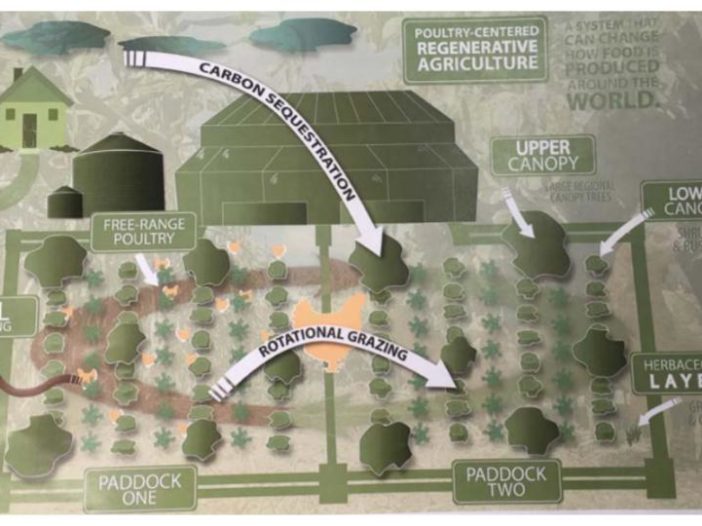
I received a recent email question: “I need help in starting a small project of free range chicken…”
I thought, “..surely, they can’t be alone.”
Free range chicken rearing appeals to many poultry beginners.
Mainly because it’s the picture perfect ideal for our image of poultry farming.

Source: Dexter’s World
An open range, virgin pasture, tree-lined windbreak and hundreds or thousands of Rhode Island Red’s rummaging and roaming for forage.
And as for the many parts of the world where Rhode Island is fathomed an exotic…
The dream of rearing a locally sought after breed (perhaps Kadaknath or Road Runner, for example) in the backyard or adjoining land equally holds a certain nostalgic allure.
Source: Global Press Journal
But whether we say free-range or backyard, rearing poultry predominantly in the outdoors is our topic of focus here today.
By appearance alone, free range poultry farming is far cry from the indoor caged, semi-intensive model.
And reports show that the free range approach is fast growing in popularity.
This is stirring both new entrants and existing producers in their droves to get invested.
But why?
Consumer trend.
People across the world in increasing numbers are preferably looking for free range meat, avoiding intensively raised product and are willing to pay premium.
What’s driving this?
For some, it’s fashion. Others, it’s personal health. For many, the idea of improved animal welfare.
But ultimately, whatever the motive, dishes like this Kadaknath curry are fast selling out in restaurants and free range meat and eggs are flying off retail shelves:

Source: The Economic Times (India)
It’s undeniable that ‘free-range’ or ‘local, country bred birds’ is a globally sustainable economic trend. And is driving the adoption of this non-industrial agricultural modes of production.
In this article, I will show you how to start your own free range poultry farming business – regardless of country or breed.
What is free range poultry farming?
Free range poultry holds different meanings depending on country.
And in some as governed by law.
Canada
“Free range birds must have access to the outdoors. However, since there is no legal definition of free range in Canada, this can vary from farm to farm.”
South Africa
“For broilers to qualify as free range, the Broiler Production Code of Practice specifies that no more than fifteen birds may be kept per square meter in the poultry shed or housing.”
Source: southafrica.co.za
Netherlands
“…10 hectares of open land for them to run around on, as demanded by law…every free-range farmer knows that if you have 10 hectares, the chickens will only use nine…we have 6.7 hens per square metre. A free-range farm would typically have nine hens per square metre.”
Source: The Guardian
Top Tip: It’s fundamental to get your local legal definition of free range poultry farming.
Advantages of small scale free-range poultry farming
Compared with semi-intensive models, small scale free range poultry farming has the following advantages:
- zero land remodelling
- minimal equipment purchase
- use your own outdoor space
- starting small is viable (quality, rather than quantity)
- leveraging premium pricing for healthier margins
- reselling animal welfare for premium return on investment
However, as prerequisite, for small scale free-range poultry farming you do need:
- pasture or equivalent outdoor roaming space
- access to discerning customers
- greater labour intensity
- coops for roosting
- diverse feeding strategy
- flock management mastery (for movement of flock)
Who is free-range poultry farming for?
Because of the points above, free-range typically favours owner/managers with experience of handling flocks. Their level of stockmanship naturally makes them competent to tackle the rigours of the discipline.
That said, previous experience is NOT essential.
Take Senthilvela, for example:

A former IBM IT project manager with no prior poultry farming experience.
Yet, today, he’s a very successful free range poultry farmer.
So, it’s evident…
…as long as you have a keen inquisitiveness and attention to detail regarding flock care – you too can make a good go of it.
Knowing Your Flock (KYC) with free-range poultry is perhaps of greater importance, especially as you are managing variable environmental factors.
Demand for free-range poultry products
Free-range poultry farming is on trend, globally.
The degree of demand varies, from country to country as you can imagine – and we’ll later look into specific examples.
But for now we’ll take the following case in isolation to identify the principle drivers of free-range poultry demand:
- Fee range eggs accounted for 62 percent of all production to pass through the country’s packing stations between July and September 2021.
- This is up from 58 percent in the second quarter of this year and 55 percent in the third quarter of 2020.
- Enriched cage production has fallen from 39 percent to 33 percent year-on-year, Defra’s figures show.
- The continued growth of free range egg production comes just four years from the target date set by many leading retailers for ending the use of all cage eggs.
- In the UK, all major retailers have committed to abandoning eggs from cages by 2025.
- Many leading food manufacturers, including Nestle, have also made the commitment.
- This year, some of the world’s biggest food companies joined in an initiative to boost supplies of cage-free egg product.
- It said the UK already had the highest proportion of free range layers of any European nation, adding it had developed a barn system that boasted a much higher standard than other countries.
Source: FarmingUK
Irrespective of the specific numbers and stats involved (because they may not be applicable to your country) take a look at the economic factors in the example above, which are driving the free-range trend.
- Do you see such factors acting in your economy?
- Are there other drivers?
Difference between free-range poultry and organic
It’s critical at this stage to make clear the difference between free-range and organic.
Here are two distinctions laid out by leading institutions:
1. Foundation Education
As opposed to standard free range farms where anything goes feed-wise, organic farms must stick to synthetic chemical-free feeds. To be officially recognised as an organic farm, hens must only eat pure, organic feed and no nasty animal by-products like egg shells and ground bones.
Source: Foundation Education
2. Soil Association:
- The size of the flock (number of hens)
- maximum flock size of 16,000, as advised by the RSPCA (UK’s ) vs. 3,000 flock size by organic standards
- The amount of space, and type of environment animals have
- allocation of 4 metres square of outdoors space per bird, with the forage rested for 2 months, according to EU regulation between flocks vs. 9 metres square and 9 month forage rest for organic flocks
- The way they are treated
- Beak trimming allowed by EU law to prevent feather pecking injuries / zero tolerance beak trimming with the Soil Association’s organic principles
- What they are fed
- GM-feed accepted under the description of free-range vs. strict, GM free diet under organic standards
- Use of antibiotics
- Antibiotics accepted for free range birds vs. no antibiotics with organically reared poultry
Source: Soil Association
Choosing the right type of free range poultry farm
Simply speaking, there are 2 modes of operation for a free range poultry farm:
1. Access to outdoors via a run from a coop
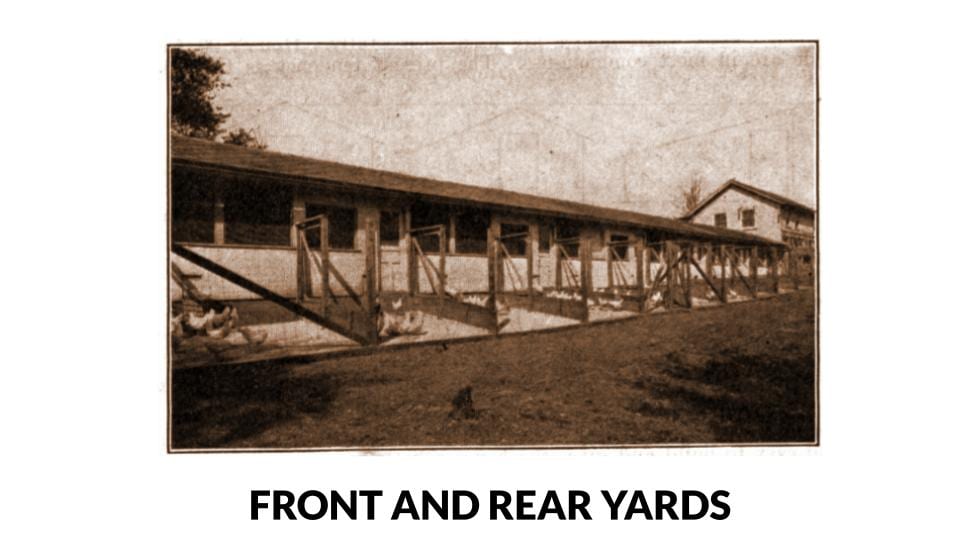
Source: Poultry Houses: 197 Designs, Structures, Plans & Systems (PDF Guide)
2. Access to an open field, or pasture
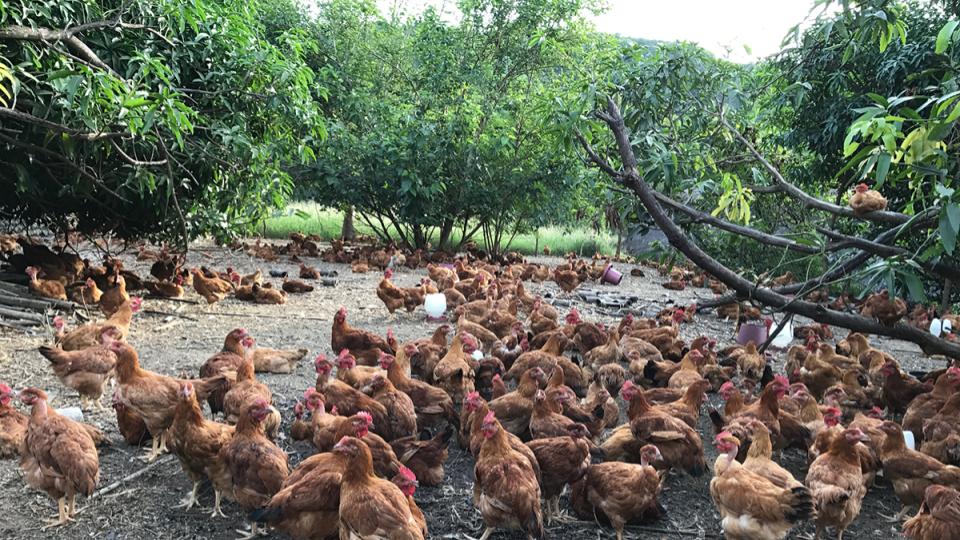
Source: How To Start A Poultry Farm Business In The Philippines (2021)
*Plus, Flock Mobility
One model variation which can be applied to both models above, and adds a twist on the theme is mobility.
Why mobility?
The land becomes nutritionally diminished as a consequence of continual feeding.
Birds need their foraging grounds to recover and become replenished.
To assist in resting the land, some farmers move the flocks and rotate plots (otherwise known as Pastured Poultry).
And there are multiple ways of moving a flock.
Here are a few options:
Wagon train coops
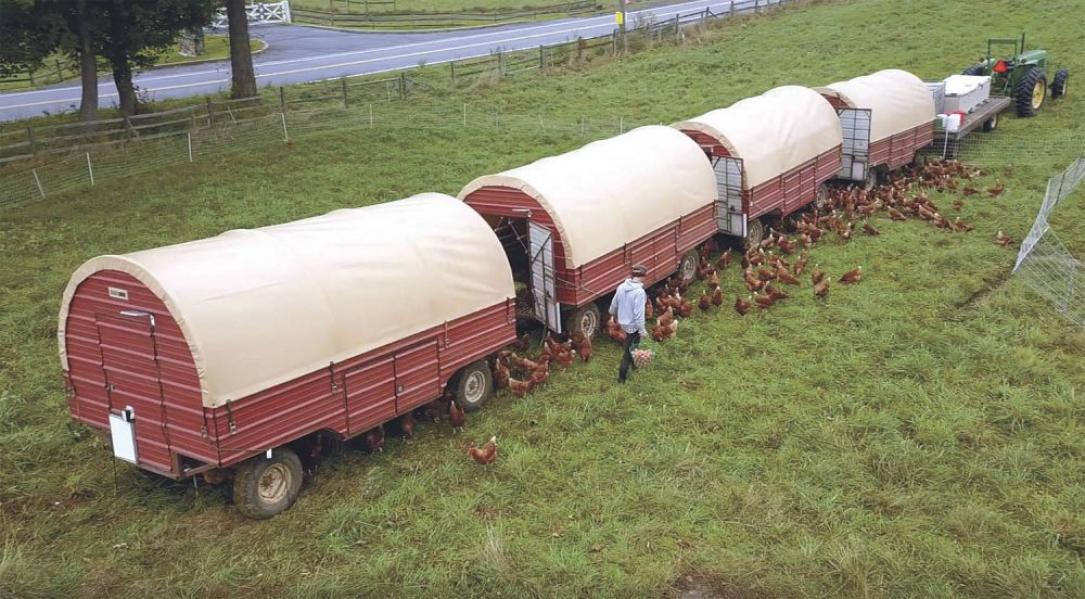
Source: Farm Show
Coop on a cart
Source: Backyard Chickens
A-Frame mobile coop
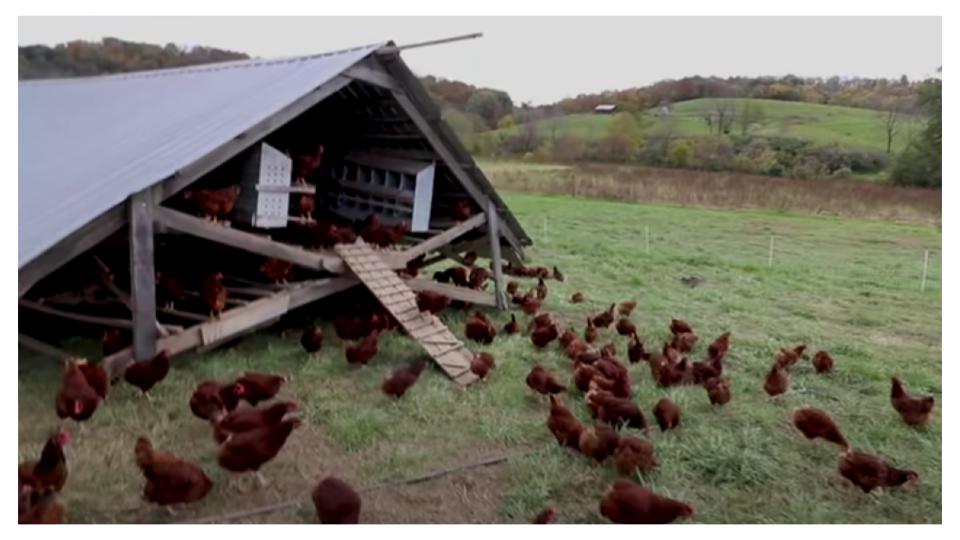
Source: Justin Rhodes
The principle remains the same, although the exact vehicle type may differ.
Regenerative poultry models
As an alternative to the mobile free range poultry units is regenerative poultry.
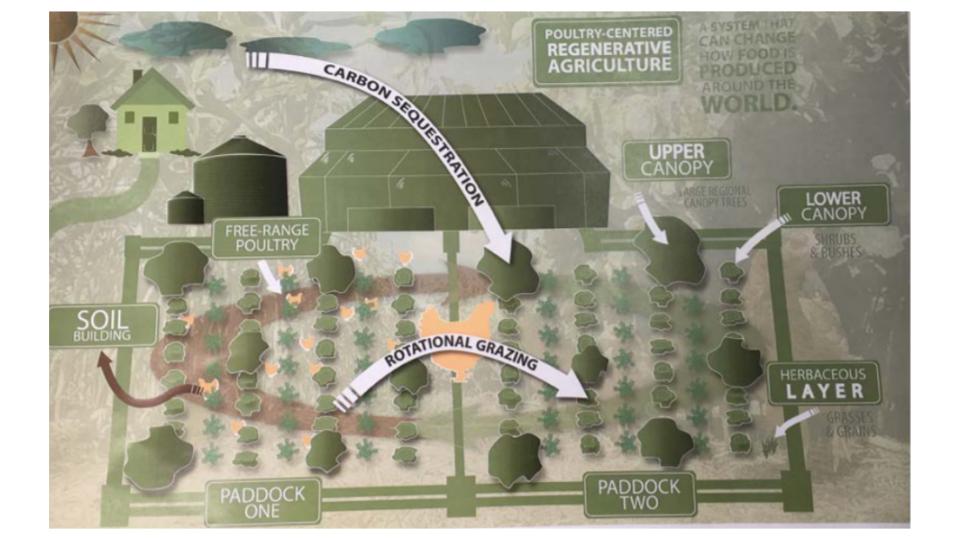
Source: Aftaweb
The land’s nutrient depletion is unavoidable if you range poultry. And as demonstrated above, one way around the obstacle is to move (re-site) your flock around your land, continually.
The downside here though is the labour intensity.
Is there a ‘lower labour impact’ method?
The answer for some is regenerative poultry farming.
The theory here is:
If you maximise the earth’s regenerative (recovery) potential to replenish the nutritional load by producing a synergistic agri-ecosystem…
…then, you get the same results as the ‘mobile method’ – only with less moving around.
By rotational grazing in alternative paddocks you can strike an optimal balance of use that sustains a profitable enterprise.
Example of a successful free range poultry farmer
Source: The Poultry Site
Meet Emerson Siscar.
Emerson is an IT consultant by trade, who turned free range chicken farmer in 2011.
11 years on – he’s succeeded at sustaining a profitable, local breed free range poultry business in the Philippines.
In an interview with The Poultry Site, Emerson reveals his rationale for choosing free range rearing:
“I wanted to pursue organic free-range poultry farming because just a few groups were dabbling in it at the time. It was definitely a ‘blue ocean’. I also dove in with a large number of chickens to make failure too expensive. I still did fail a few times – and that’s how I learned the lessons which are keeping us afloat today.”
Source: The Poultry Site
Emerson has adopted a hybrid farming model that again leans upon the leveraged benefits of complimentary elements in an ecosystem.
Source: The Poultry Site
Here’s how his farm is set up:
“[He] manages a two-hectare organic poultry farm in the hills of Santa Teresita, Batangas – a sparsely vegetated area dominated by vegetable growers. His farm is roughly divided into a dozen organic chicken and egg production plots. Eight are fenced-off areas with coops, baskets and egg cabinets for layers, while four are spacious lots with coops for broilers. The rest of the land is used to grow herbs and vegetables like corn, eggplant, bitter gourd, lemon grass, banana, papaya and azolla, a floating aquatic plant with 30 percent protein content used to augment chicken feed.”
Source: The Poultry Site
Emerson’s birds are what are classed as ‘slow-grow’ meat birds.
The key ‘slow-grow’ characteristics look like this:
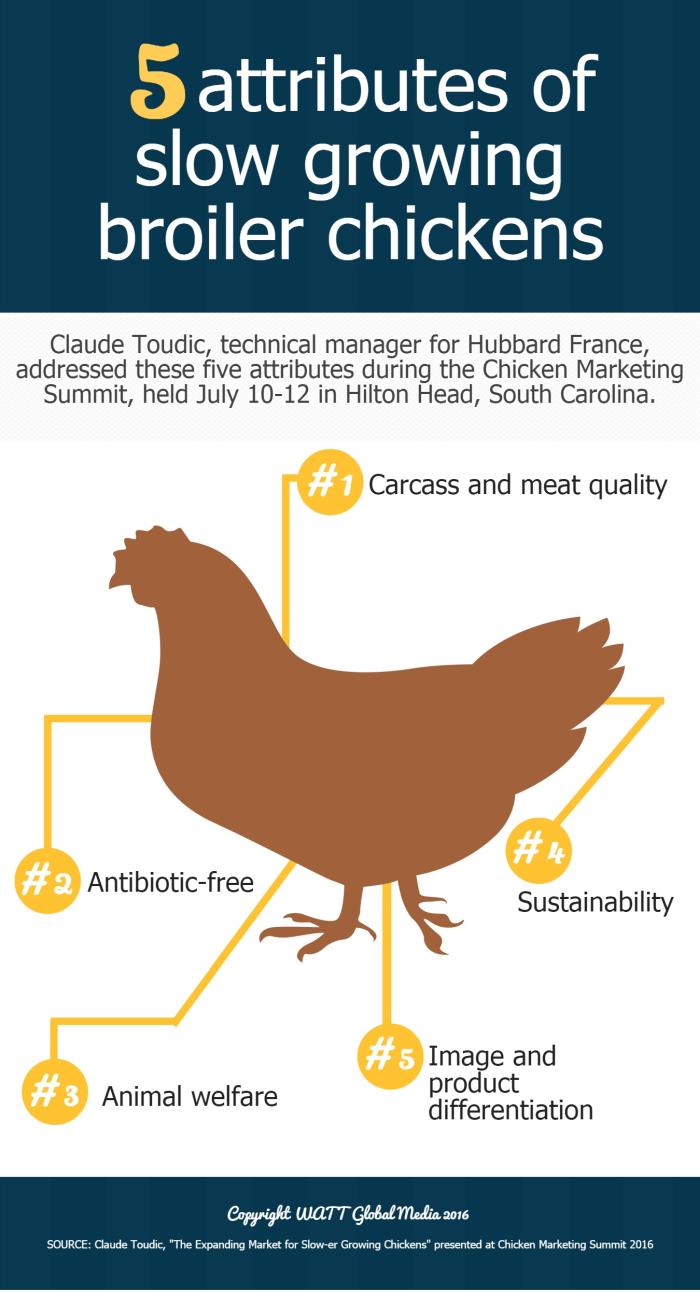
Source: WATTAgNet
And performance wise…
…here’s a quick comparison graphic of the key differences between ‘slow-grow’ free range/organic birds vs. indoor reared commercial breeds, like Cobb 500, for example:
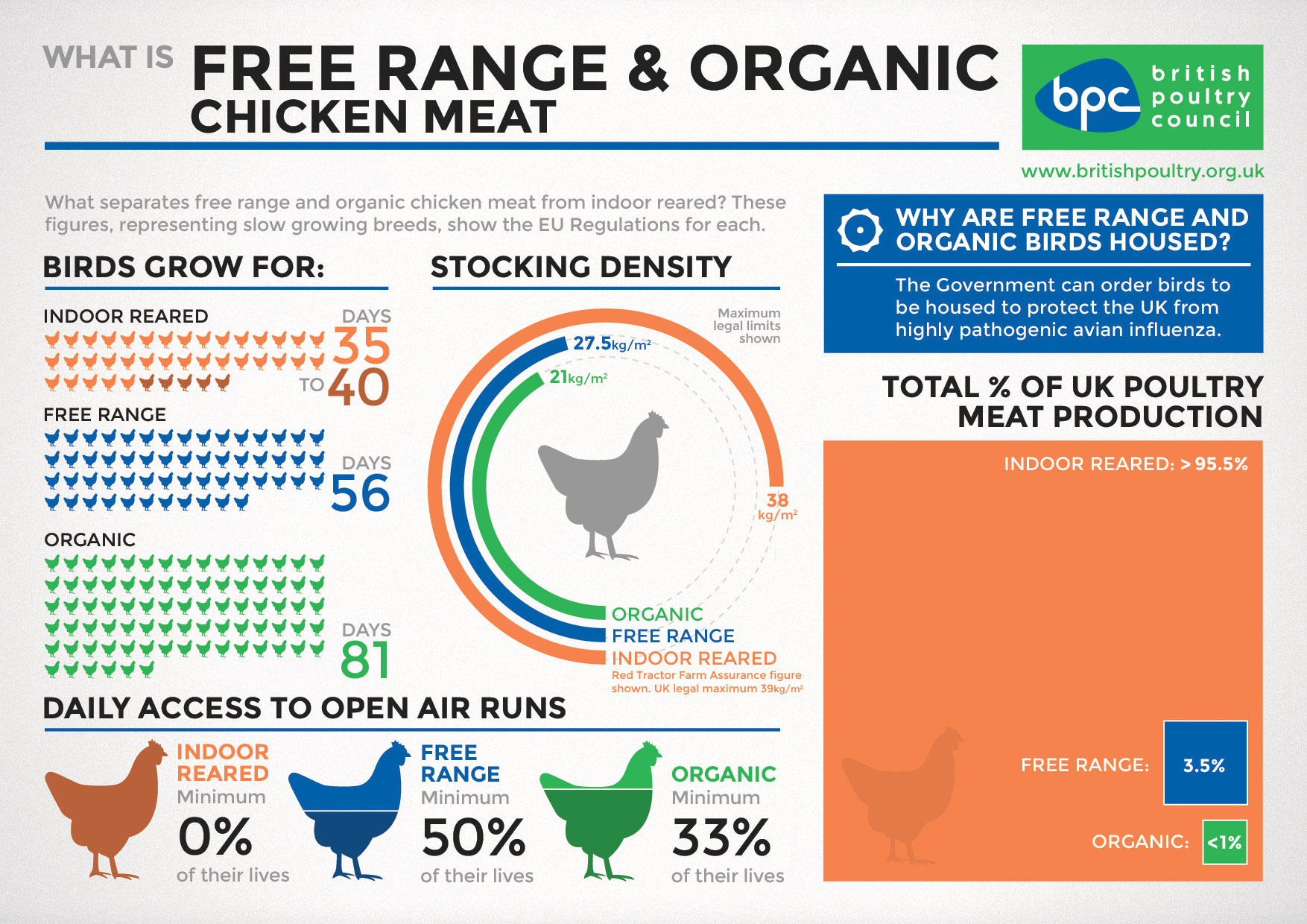
Source: The British Poultry Council
In short, ‘slow-grow’ differ in that they…
- don’t achieve the rapid growth like their genetically-engineered cousins the commercially bred broiler.
- thrive on open rearing space, incurring greater rearing cost than broilers.
- achieve lower live weights are lower than broilers – meaning you take less product to market.
(And more so, if you aim for organic status further stipulations must be met on feed standards raising the direct input costs.)
But on the flip-side, the premium pricing paid for ‘slow-grow’ free range and organic poultry – at least in Emerson’s native Philippines – is buoyant. This makes the model sustainable, although more patient and labour intensive.
Here’s a brief cost-benefit consideration of raising ‘slow-grow’ organic birds:
“Organic free-range chicken meat is a premium item, but production must always comply with strict standards,” explains Emer. “Feeds can’t contain animal protein so we make a special mixture of corn, soy and vegetable pellets. We don’t use antibiotics or growth hormones, so our brown broilers take a longer time to reach a live weight of 1.5kg to 2kg – about 75 days compared to the 28-day-old chickens produced by factory farms. Still, our chickens retail for much more – up to 400 pesos or US$8 per kilogram compared with around 120 pesos or $2.5 for non-organic chicken, so the extra time, effort and love we give them pays dividends.”
Source: The Poultry Site
One reality of the premium free-range production model though is B-class birds.
Not all birds make higher the standard.
And so, to save losing out on potential gain (from substandard stock) – producers like Emerson need to get witty:
Not all birds make the cut, however, which is why Emer developed creative ways to sell rejected but still high-quality dressed chicken. “I sold quite a few batches of B-quality chickens at a loss before I realised they were perfectly acceptable for lower-tier markets. Today we offer these quality dressed chickens to supermarkets. I’m even coming up with my own barbequed chicken line. To succeed in the poultry business, you have to maximise involvement in each step of the supply chain.
“The last thing we want is to waste resources and opportunities.”
Source: The Poultry Site
And why stop there?
Now that Emerson has seen the commercial advantage in thinking quickly on his feet, he’s leveraging all sorts of advantages by thinking outside of the box:
“We’ll now dabble with native black Ulikba chickens, popular in Chinese restaurants. We’re developing our own feeds. Plus the barbecue line. Since that workshop with Mr Kiyosaki, I’ve found that the best way to really thrive is to innovate. By doing so, we’ll always sail smooth in a blue ocean.”
Source: The Poultry Site
On that note, let’s now examine the steps for starting your own free range poultry farm.
How to start a free range poultry farm
To start a free range poultry farm of any type successfully, you’ll need to follow these principle steps:
1. Set your earning expectations
Reverse engineer your free range poultry farm earnings.
Decide what proportion of your personal outgoings that you want the farm to contribute.
For example, if your expected salary from running the farm is ₱187,400, then this sets your farms minimum EBITA (earnings before interest, tax and amortisation) at ₱187,400 – plus deductions.
Source: Salary Expert
Now, build a model to support your aim.
2. Research the free range market (B2B & B2C)
Discover your national, regional and local free range poultry market.
Find reports and studies either from governmental sources, news networks, organisations or commercial entities.
For example:
“The production of agricultural crops has been rising at a rate of 1.5–2 per cent per annum, whereas eggs and broilers have been shown to rise at a rate of 8-10 per cent per annum but the growth has been mainly restricted to commercial poultry.”
Source: Krishijagran
Then, analyse the detail for trends and insights that might help guide you in a prudent industry outlook.
3. Visit a local free range poultry farm
Contact your local agricultural extension lead with government and ask them for your local free range poultry demo farm.
Book a site visit – prepare questions and take notes.
4. Decide on product (eggs, meat or both)
Egg farming vs. chicken meat farming although are both classed as poultry – are very different modes of rearing operation.
Compare the production profiles of both egg and meat production alongside the resulting cash flow schedules.

Get the Poultry Project Reporter 2.0 ebook today
It’s worth planning in advance and preparing yourself for when you should expect to see your revenue flow in.
5. Extrapolate target scale and production
Using your expected earnings and bearing in mind your chosen product type (eggs, meat or both) – simply take the base unit, either a carcass or egg and multiply the output to meet your expected earnings.
For example, this guide will help you produce an accurate egg estimate:
Chicken egg production calculation
6. Choose model
Every livestock farmer knows you don’t just grow a flock or herd, you build a model.
The model is engineering. A technical gearing that picks up the strain of production and delivers predictable results with failsafe and contingency built in.
Here’s an example, with broiler farming an entire flock is sold at market date.
If this was your only flock – you’d suffer cash flow outage whilst waiting for another.
6 weeks at commercial best, or 12 weeks perhaps for slow-grow.
Among chicken meat farmers there are therefore some popular tried a tested production models to smooth out your production diary and cash flow.
Take a look at these two example broiler models.
7. Question feasibility
As some questions of your concept so far with a feasibility plan.
Test feasibility by kicking the wheels of your plan thus far and seeing if your idea will stand up in principle to the buffeting of the external economy.
Also, such a study will prove your internal financial planning too.
Take a look at this proposal for free range poultry production.
8. Validate your idea and pricing with buyers
At this stage you’ll be quite comfortable with how your poultry farm model will succeed and make money.
But how confident can you really be without real buyer interest?
- Make contact with prospective buyers.
- Propose your product and farm stories.
- Solicit buyer feedback and certainty of interest to buy at desired price.
9. Write a 6-year project plan
Build a project report that generates an accurate financial projection of your planned farming business.
A project report gives you:
- a detailed picture of costs required to start
- calculated profit and cash flows to be expected
- working capital
- benefit cost ratio
Not only that, but your project report will generate accurate production estimates for your chosen multi-flock rearing model.
Use Poultry Project Reporter 2.0 software to write your poultry project report – in minutes.

The software is PDF fillable meaning all you need to do is feed it with the raw data…
…and it will do the rest (calculations, formatting and fill in the gaps).
10. Examine local laws
Contact your local agri-extension or planning office.
They will be working towards achieving certain strategic goals within your area.
Win their support:
Interview your local officer and receiving all relevant documentation on what goals they are trying to hit.
Simply align your free range poultry farm to dovetail with their purposes.
11. Incorporate your business
Access the necessary covenants, paperwork and learning material concerning starting up a business in your country, region or district.
You should find these resources on your Government’s website.
Take Uganda, for example:
This web page is the official guide for starting a business in Uganda.
Source: Uganda National Web Portal
12. Direct Sales and Marketing
As a producer, there are incomparable benefits from getting your product to market (face-to-face) with buyers directly.
Most of all, with the right direct marketing (DM) approach you can master building a pipeline of demand.
Use a proven B2B (business to business) direct sales and marketing strategy as a blueprint to attract ready buyers for your free range product.
Such buyers might include:
- hotel chefs
- restaurant owners
- local food processors
- caterers
- wholesalers
- farmers’ markets
Download the Direct Marketing Masterclass for a next level tutorial in how to win new buyer contracts.
13. Make templates for journalling and record keeping
Poultry farmers that keep diligent records see round corners.
A very advantageous skill to have.
Learning on the job should never stop in poultry and journalling your observations is the foundation to excelling your understanding.
Use a blog for keeping a daily record of your observations. I recommend using WordPress and Genesis Theme for this.
Plus, use an online template like Broiler Production Record Template to stay up on your daily flock audit.
14. Bookkeeping & Accounting
Staying abreast of your numbers keeps you financially astute.
Use tried and tested templates to keep your figures in check. Plus, use KPI dashboarding to stay on top of vital statistics.
I recommend using an automated framework that is customised for a meat or egg farm.
Subscribe to my course Poultry Farming Records, Bookkeeping and Accounting.
14. Plan & acquire land
If you come in to this without your own land, you’ll need to use a land broker.
But before you get serious about acquisition – first get a solid understanding of the type of land that would best suit your free range poultry farm.
Search online for free range poultry farms and take notes of the land features that they share.
Read this quick checklist from Virbac that outlines the main pointers to consider.
15. Plant and shape landscape
This is probably more inline with the regenerative methods.
But regardless, the use of land is critical to maintaining production standards on your free range poultry farm.
Read this PDF from the Woodland Trust on tree planting best practice for free range chicken farms.
16. Build housing
This depends on what type of housing you will adopt.
Coop, mobile coops, automated etc.
I recommend you examine closely the pros and cons as well as the design features, flaws and plans for feasibility.
Read my guide on Poultry Houses: 197 Designs, Structures, Plans & Systems (PDF Guide) – it is comprehensive.
17. Buy equipment
Feeders, drinkers, vehicles etc. all of this kit will be necessary for keeping your farm operational.
Not only will you need to know what to use, but how to use it.
I recommend this Free Range Chicken Production Manual by Reginaldo Haslett-Marroquin for a detailed breakdown of exactly what you should be looking at using and why.
18. Secure supply chain deals
Feed, chicks, equipment etc.
Getting advantageous commercial arrangements with suppliers that minimise your costs and deliver consistent quality is key to sustainable profits.
Study this guide on Farmers’ Supply Chain Best Practices by AgEcon – it gives you techniques and strategies for maximising your bargaining power to lower cost.
Conclusion
There are so many methods and variations of model to choose from when setting up a free range poultry farm.
I have outlined a number of options within this guide to help you find your feet.
Plus, you’ve got above a simple step-by-step process for getting started.
If you still are looking for a competent trainer or advisor to assist you in a hands-on fashion along your journey, then I recommend subscribing to Advanced Poultry Pickup my comprehensive training program.
Now over to you…
Are you currently thinking about starting a free range poultry farm from scratch?
Do you have experience with indoor rearing only and are considering changing codes of practice?
Either way, I’d be interested to hear from you.



Leave a Reply